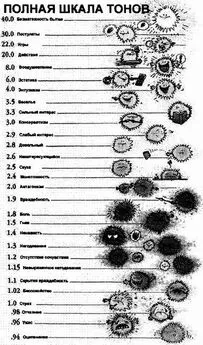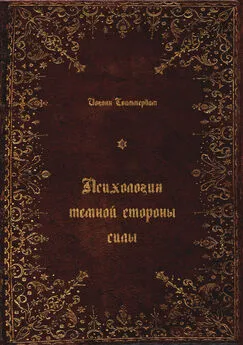Джулия Шоу - Психология зла. Почему человек выбирает темную сторону
- Название:Психология зла. Почему человек выбирает темную сторону
- Автор:
- Жанр:
- Издательство:Альпина Паблишер
- Год:2020
- Город:Москва
- ISBN:978-5-9614-3544-3
- Рейтинг:
- Избранное:Добавить в избранное
-
Отзывы:
-
Ваша оценка:
Джулия Шоу - Психология зла. Почему человек выбирает темную сторону краткое содержание
«Психология зла» - это подробное и увлекательное исследование темной стороны человека. Доктор Джулия Шоу на примерах из массовой культуры и реальной жизни предлагает порассуждать о проблемах, о которых обычно молчат, хотя знание факторов, способных спровоцировать недопустимое поведение, помогает замечать их и не давать им развернуться в полную силу.
Психология зла. Почему человек выбирает темную сторону - читать онлайн бесплатно ознакомительный отрывок
Интервал:
Закладка:
Richardson, D. S., & Hammock. G. S. ‘is it aggression? Perceptions of and motivations for passive and psychological aggression’. The Psychology of Social Conflict and Aggression , 13 (2011), pp. 53-64.
27
Paulhus, D. L., Curtis, S. R., & Jones, D. N. ‘Aggression as a trait: the dark tetrad alternative’. Current Opinion in Psychology, 19 (2017), pp. 88-92.
28
Paulhus, D. L. ‘Toward a taxonomy of dark personalities’. Current Directions in Psychological Science, 23 (6) (2014), pp. 421-6.
29
Balsis, S., Busch, A. J., Wilfong, K. M., Newman, J. W., & Edens, J. F. ‘A statistical consideration regarding the threshold of the psychopathy checklist — revised’. Journal of Personality Assessment, 99 (5) (2017), pp. 1-9.
30
Augstein, H. F. ‘J. C. Prichard’s concept of moral insanity — a medical theory of the corruption of human nature’. Medical History, 40 (3) (1996), p. 311.
31
Hare, R. D. The Hare Psychopathy Checklist — Revised, 2nd ed. Toronto, ON: Multi-Health Systems, Inc., 2003.
32
Poeppl, T., Donges, M., Rupprecht, R., Fox, P., . . . & Eickhoff, S. ‘Meta-analysis of aberrant brain activity in psychopathy’. European Psychiatry, 41 (2017), S349.
33
Stromberg, J. ‘The neuroscientist who discovered he was a psychopath’. Smithsonian, 22 November 2013; http://www.smithsonianmag.com/science-nature/the-neuroscientist-who-di scovered-he-was-a-psychopath-180947814/.
34
Fallon, J. The Psychopath Inside: A Neuroscientist’s Personal Journey into the Dark Side of the Brain. London: Penguin, 2013.
35
Konrath, S., Meier, B. P., & Bushman, B. J. ‘Development and validation of the single item narcissism scale (SINS)’. PLOS ONE, 9 (8) (2014); https://doi.org/10.1371/journal.pone.0103469.
36
Goldbeck, J. ‘The one question that can tell us who’s a narcissist: a new study finds a surprising insight about personality’. Psychology Today, 16 September 2014; https://www.psychologytoday.com/blog/your-online-secrets/201409/the-one-question-can-tell-us-whos-narcissist/.
37
Krizan, Z., & Johar, O. ‘Narcissistic rage revisited’. Journal of Personality and Social Psychology, 108 (5) (2015), pp. 784-801; https://doi.org/10.1037/pspp0000013.
38
Jones, D. N., & Paulhus, D. L. ‘Machiavellianism’. In: M. R. Leary & R. H. Hoyle (eds), Handbook of Individual Differences in Social Behavior. New York: Guilford Press, 2009, pp. 93108.
39
Muris, P., Merckelbach, H., Otgaar, H., & Meijer, E. ‘The malevolent side of human nature: a meta-analysis and critical review of the literature on the dark triad (narcissism, Machiavellianism, and psychopathy)’. Perspectives on Psychological Science, 12 (2) (2017), pp. 183-204.
40
Christie, R., & Geis, F. L. Studies in Machiavellianism. New York, NY: Academic Press, 1970.
41
Buckels, E. E., Jones, D. N., & Paulhus, D. L. ‘Behavioral confirmation of everyday sadism’. Psychological Science, 24 (11) (2013), pp. 2201-09.
42
Campbell, W. K. ‘Is narcissism really so bad?’ Psychological Inquiry, 12 (4) (2001), pp. 21416.
43
Darimont, C. T., Fox, C. H., Bryan, H. M., & Reimchen, T. E. ‘The unique ecology of human predators’. Science, 349 (6250) (2015), pp. 858-60.
44
Kenrick, D. T., & Sheets, V. ‘Homicidal fantasies’. Ethology and Sociobiology, 14 (4) (1993), pp. 231-46.
45
Duntley, J. D., & Buss, D. M. ‘Homicide adaptations’. Aggression and Violent Behavior, 16 (5) (2011), pp. 399-410.
46
Норма права «ограниченная вменяемость» применяется при нарушениях умственного развития или снижении когнитивных функций, возникшем в результате алкогольной зависимости. — Прим. пер.
47
United Nations Office on Drugs and Crime. Global Study on Homicide 2013: Trends, Contexts, Data. New York: UNODC, 2013.
48
Roberts, A. R., Zgoba, K. M., & Shahidullah, S. M. ‘Recidivism among four types of homicide offenders: an exploratory analysis of 336 homicide offenders in New Jersey’. Aggression and Violent Behavior, 12 (5) (2007), pp. 493-507.
49
Татуировка в виде слезы под глазом — одна из распространенных тюремных татуировок в США. — Прим. ред.
50
Liem, M. ‘Homicide offender recidivism: a review of the literature’. Aggression and Violent Behavior, 18 (1) (2013), pp. 19-25.
51
Archer, J. ‘Sex differences in aggression in real-world settings: a meta-analytic review’. Review of General Psychology, 8 (4) (2004), p. 291.
52
Dabbs, J. M., Riad, J. K., & Chance, S. E. ‘Testosterone and ruthless homicide’. Personality and Individual Differences, 31 (4) (2001), pp. 599-603.
53
Cooper, S. E., Goings, S. P., Kim, J. Y., & Wood, R. I. ‘Testosterone enhances risk tolerance without altering motor impulsivity in male rats’. Psychoneuroendocrinology, 40 (2014), pp. 201-12.
54
Berthold, A. A. ‘Transplantation der Hoden’. Archiv für Anatomie, Physiologie und Wissenschaftliche Medicin, 16 (1849), pp. 42-46.
55
Berthold, A. A., & Quiring, D. P ‘The transplantation of testes’. Bulletin of the History of Medicine, 16 (1944), p. 399.
56
Carre, J. M., Ruddick, E. L., Moreau, B. J., & Bird, B. M. ‘Testosterone and human aggression’. In: The Wiley Handbook of Violence and Aggression, Peter Sturmey (ed.), Hoboken, NJ: Wiley-Blackwell, 2017.
57
Mazur, A., & Lamb, T. ‘Testosterone, status, and mood in human males’. Hormones and Behavior, 14 (1980), pp. 236-46; https://doi.org/10.1016/0018-506x(80)90032-x.
58
Crockett, M. ‘The trolley problem: would you kill one person to save many others?’ The Guardian, 12 December 2016; https://www.theguardian.com/science/head-quarters/2016/dec/12/the-trolley-problem-would-you-kill-one-person-to-save-many-others/.
59
Skulmowski, A., Bunge, A., Kaspar, K., & Pipa, G. ‘Forced-choice decision-making in modified trolley dilemma situations: a virtual reality and eye tracking study’. Frontiers in Behavioral Neuroscience, 8 (2014).
60
Bleske-Rechek, A., Nelson, L. A., Baker, J. P., Remiker, M. W., & Brandt, S. J. ‘Evolution and the trolley problem: people save five over one unless the one is young, genetically related, or a romantic partner’. Journal of Social, Evolutionary, and Cultural Psychology, 4 (3) (2010), pp. 11527.
61
Greene, J. D., Morelli, S. A., Lowenberg, K., Nystrom, L. E., & Cohen, J. D. ‘Cognitive load selectively interferes with utilitarian moral judgment’. Cognition, 107 (3) (2008), pp. 1144-54.
62
Garrigan, B., Adlam, A. L., & Langdon, P E. ‘The neural correlates of moral decision-making: a systematic review and meta-analysis of moral evaluations and response decision judgements’. Brain and Cognition, 108 (2016), pp. 88-97.
63
Jentzen, J., Palermo, G., Johnson, L. T., Ho, K. C., . . . & Teggatz, J. ‘Destructive hostility: the Jeffrey Dahmer case: a psychiatric and forensic study of a serial killer’. American Journal of Forensic Medicine and Pathology. 15 (4) (1994), pp. 283-294.
64
Terry, D. ‘Jeffrey Dahmer’. The New York Times, 29 November 1994; http://www.nytimes.com/1994/11/29/us/jeffrey-dahmer-multiple-killer-is-bludgeoned-to-death-in-prison.html?mcubz=0.
65
Terry. ‘Jeffrey Dahmer’.
66
Wiest, J. B. Creating Cultural Monsters: Serial Murder in America. Boca Raton, FL: CRC Press, 2016.
67
Hodgkinson, S., Prins, H., & Stuart-Bennett, J. ‘Monsters, madmen . . . and myths: a critical review of the serial killing literature’. Aggression and Violent Behavior, 34 (2017), pp. 282-89.
68
Апология Сократа. Пер. С. А. Жебелева // Полное собрание творений Платона в 15 томах. Т 1. — Петербург: Academia, 1923.
69
McAndrew, F. T., & Koehnke, S. S. ‘On the nature of creepiness’. New Ideas in Psychology, 43 (2016), pp. 10-15.
70
Bar, M., Neta, M., & Linz, H. ‘Very first impressions’. Emotion, 6 (2006), pp. 269-78; http://dx.doi.org/10.1037/1528-3542.6.2.269.
71
Porter, S., England, L., Juodis, M., Ten Brinke, L., & Wilson, K. ‘Is the face a window to the soul? Investigation of the accuracy of intuitive judgments of the trustworthiness of human faces’. Canadian Journal of Behavioural Science / Revue canadienne des sciences du comportement, 40 (3) (2008), p. 171.
72
Petridis, A. ‘One person’s “edgy” model is another’s gun-toting “street terrorist”’. The Guardian, 3 July 2014; https://www.theguardian.com/lifeandstyle/lostinshowbiz/2014/jul/03/edgy-model-gun-toting-street-terrorist-jeremy-meeks.
73
Nisbett, R. E., & Wilson, T. D. ‘The halo effect: evidence for unconscious alteration of judgments’. Journal of Personality and Social Psychology, 35 (4) (1977), p. 250.
74
Thorndike, E. L. ‘A constant error in psychological ratings’. Journal of Applied Psychology, 4 (1920), pp. 25-29.
75
Gibson, J. L., & Gore, J. S. ‘You’re OK until you misbehave: how norm violations magnify the attractiveness devil effect’. Genderissues, 32 (4) (2015), pp. 266-78.
76
Вы когда-нибудь замечали, что слова devil (дьявол) и evil (зло) отличаются всего одной буквой? Это напоминает нам, как тесно связаны религиозные понятия «дьявол» и «проступок». — Прим. авт.
77
Hosoda, M., Stone-Romero, E. F., & Coats, G. ‘The effects of physical attractiveness on job-related outcomes: a meta-analysis of experimental studies’. Personnel Psychology, 56 (2) (2003), pp. 431-62.
78
Phelan, S. M., Burgess, D. J., Yeazel, M. W., Hellerstedt, W. L., . . . & Ryn, V. M. ‘Impact of weight bias and stigma on quality of care and outcomes for patients with obesity’. Obesity Reviews, 16 (4) (2015), pp. 319-26.
79
Adolphs, R., & Tusche, A. ‘From faces to prosocial behavior: cues, tools, and mechanisms’. Current Directions in Psychological Science, 26 (3) (2017), pp. 282-87.
80
Интервал:
Закладка:










